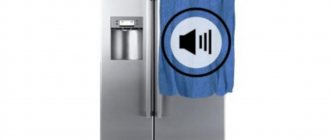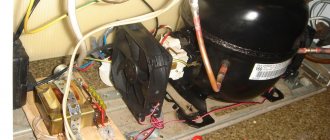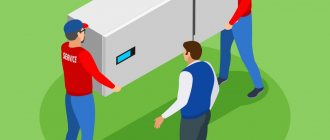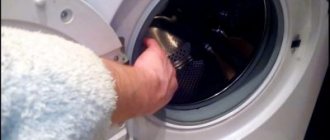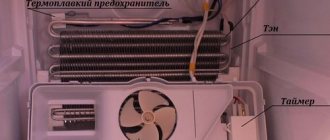Reasons for increased cold formation
What should I do if my refrigerator freezes food in the refrigerator compartment excessively? Often the reasons for this phenomenon are not related to the breakdown of household appliances . They occur due to incorrect use of the device.
In units with a drip defrosting system, moisture from the food evaporates and settles in drops on the back wall of the chamber. It freezes when the compressor is running. When it stops, the frost melts and the water flows through the drainage system into a special bath.
If dishes with liquids without lids, hot foods and containers are placed in the chamber, excess moisture occurs . It settles on the wall, freezes, but does not have time to thaw, and an ice crust forms. Over time it increases. Because of this, nearby products begin to freeze.
If the device door is opened frequently and left open for a long time , the compressor runs continuously to cool the chamber to the desired temperature. This also causes the food to become over-chilled.
Reference. To correct the situation, the unit is defrosted and the operating requirements recommended by the manufacturer are followed.
The influx of cold into the chamber occurs due to the continuous operation of the compressor . This happens when the thermostats are set to super-freeze and fast-cool. In this case, the unit freezes severely, but this does not happen for long. If you forget to turn off the mode, food freezes in the refrigerator.
Increased cold formation also occurs due to malfunctions in household appliances. Some of them resolve on their own. To diagnose and repair more complex ones, call a qualified specialist .
If the refrigerator freezes food, there are different reasons:
- seal wear;
- blockage in the drainage system;
- breakdown of the thermostat or air sensor;
- valve failure in a single-compressor unit;
- freon leak;
- problems with the No Frost system.
DIY repair methods
You can start repairing a refrigerator with your own hands only if a person is confident in his own abilities and has at least a vague idea of the internal structure of a household appliance. Turning the thermostat or replacing the rubber seal is not difficult; almost anyone can do it.
It’s another matter if the cause of food freezing is damage to the control valve or a freon leak. The work can hardly be done independently. If such a situation arises, you need to look for a reliable workshop where experienced specialists will quickly and efficiently carry out repairs.
Subscribe to our Social networks
The most common reasons why the refrigerator gets very cold
When household appliances start to get very cold, ice forms on the back wall . Products touching it freeze, lose their taste and spoil. To get rid of the problem, first find out why the refrigerator is freezing. Check whether the operating rules of the device are followed, whether the maximum mode and freezing mode are set on the thermostat. If necessary, the device is adjusted.
Then check whether the unit door is tightly closed and whether the rubber seal is worn out . The gasket becomes unusable under the influence of temperature changes, moisture and dirt. It dries out and cracks appear on it. The unit door no longer fits tightly to the body.
As a result, warm air constantly enters the chamber . The compressor starts working continuously to cool it down. An ice crust appears on the back wall, and water accumulates in the drainage system, which does not have time to evaporate. Due to the constant operation of the motor, the products are cooled beyond normal. Food near the ice freezes.
To check the tightness of the chamber, use a regular sheet of paper . It is placed between the body and the door. If it is easily pulled out by hand or falls out, the gasket is changed. First, remove the old one. The door is cleaned of dirt and dried. Then insert a new rubber band and secure it with glue or screws.
If the chamber is sealed, check to see if the drain hole is clogged . Typically, condensation that forms on the walls of the refrigerator compartment flows through the drainage. When clogged, water accumulates under the fruit and vegetable trays. This leads to freezing of food. In this case, the freezer works without failure.
What to do when the refrigerator freezes food? To fix the problem, the unit is defrosted . Then, using a thin wire, carefully push the debris plug through. After that, warm water is poured into the outlet channel using a syringe.
More complex breakdowns require special knowledge and skills . To find the causes of breakdowns and troubleshoot problems, contact specialists. While waiting, the products are moved away from the walls and moved to a warmer part of the chamber.
Advice. You cannot leave equipment in a faulty condition. This will lead to more serious consequences and expensive repairs.
Let's look at the most common reasons why the refrigerator freezes.
Broken thermostat or air sensor
The refrigerator gets very cold when the temperature sensor breaks down .
The faulty part gives a signal that the chamber is warm, and the compressor begins to work continuously, cooling the air. At the same time, icing appears on the back wall of the chamber and the food freezes slightly. In electromechanical models, the manual thermostat (thermostat) is located under the freezer . Its failure is outwardly invisible. Causes of failure: natural wear, voltage surges, moisture on the contacts.
To check serviceability, the part is removed and tested with a tester . If the indicators are zero, this means that the thermostat is intact. If not, then it is replaced with a new one. In models with electronic control, the microclimate is monitored by an air sensor. It is not recommended to check it yourself. It is better to entrust the replacement of a part to a specialist.
Valve fault
Such a breakdown occurs in single-compressor units . In the main compartment, food freezes, while the temperature in the freezer is higher than the set temperature. This occurs due to a broken switch valve. It should alternate cooling modes in different compartments, but it “sticks” in one position. To fix the problem, the broken part is replaced with a new one with the help of a specialist.
Freon leak
If the refrigerator gets very cold, but the compressor does not turn off, and ice has formed on the back wall, then the reason may be a freon leak . It comes out through microcracks in the cooling system, through joints. Specialists find places of damage, seal them and charge the system with refrigerant.
Problems with No Frost
The evaporator in a unit with a No Frost system is located in the freezer . The refrigerator compartment receives cold through an air duct, which is equipped with a damper. In this case, it is necessary that the evaporator tube thaws. When problems occur in the defrost system, this does not happen; it becomes overgrown with ice and heat transfer decreases.
There is not enough cold in the refrigerator compartment, the compressor turns on . It blows cold air into the freezer and it gets very cold. The reason may be a failure of the defrost sensor, evaporator heating element, defroster, fuse, or an open timer circuit. To fix the problem, they call a specialist who carries out diagnostics and finds the problem.
In units with a No Frost system, an imbalance may occur during defrosting of one of the chambers . At the same time, the refrigerator compartment freezes, but the freezer is warm, the motor runs almost non-stop. This occurs when the capillary system is clogged, when a blood clot forms in the tube due to burnt engine oil. The motor cannot pump freon.
A specialist is called to fix the problem . He cleans the system, recharges the unit with refrigerant and changes the oil if necessary.
Checking the thermostat settings
Often the refrigerator freezes food due to incorrect settings of the thermostat . To fix the problem, it is configured manually. The optimal position in mechanical models is between 2 and 3.5. The temperature is set in an electronically controlled device, the optimal value is from +4 to +6°C. Make sure your refrigerator is not set to “super freeze” and turn it off.
Advice. If the room is hot, do not set the thermostat to maximum. A working unit will cope with cooling in such conditions without adjustment. But excessive load will lead to its breakdown.
What to pay attention to
Before looking for the cause inside the mechanisms of the device, you need to make sure that the temperature controller is working correctly. Often the owners themselves are to blame for the fact that the refrigerator is very cold and the temperature inside the device has dropped below the permissible level. This causes the food to freeze. Most often this happens due to accidental pressing of the regulator knob. Therefore, make sure that the adjusting lever is always in the middle. An error of 1-2 divisions is allowed.
You need to turn the handle several times, because the failure could have occurred due to the fact that the spring was jammed in the regulator.
Modern models have an additional electronic menu where special modes are set that are responsible for super-freezing or super-cooling foods placed in the refrigerator. These modes may be set by default and ice will begin to freeze on the walls. Therefore, check them and, if necessary, adjust them manually.
What should the temperature in the refrigerator be?
The optimal temperature in the refrigerator compartment is from +4 to +6°C . It is set on the thermostat. In the freezer, -18°C is considered optimal. It will be effective if the rules for operating the compartment are followed. If it is used rarely and there are few products in it, then the best value is considered to be -14°C. When the shelves are overcrowded, the indicator is set to -24°C.
When distributing preparations and ready-made dishes on the shelves of the unit, take into account that each zone has its own temperature regime:
- freezer – from -6 to -24°C;
- the top and bottom shelves (depending on the location of the freezer) are the warmest - from +8 to +9°C;
- central shelf – average from +2 to +6°C;
- the door of the unit is the hottest place, heats up to +10°C.
